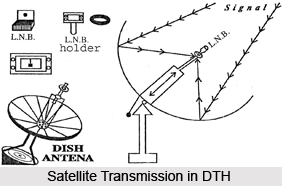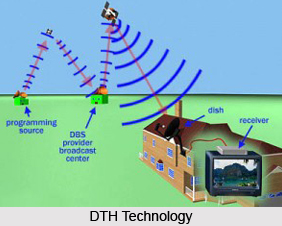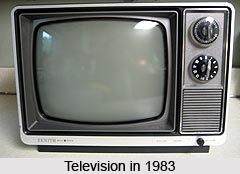 Satellite television in India is delivered by the means of communications satellite and received by a satellite dish and set-top box. Satellite television provides a wide range of channels and services, often to areas that are not serviced by terrestrial or cable providers.
Satellite television in India is delivered by the means of communications satellite and received by a satellite dish and set-top box. Satellite television provides a wide range of channels and services, often to areas that are not serviced by terrestrial or cable providers.
While Doordarshan was expanding rapidly during the 1980s, the cable television industry was mushrooming in the prime cities of India. The VCR greatly multiplied entertainment options for Indian audiences, providing alternatives to Doordarshan`s single-channel programming. Video viewing at home and in community-based video parlors increased at a fast pace. The video collection consisted mostly of film-based entertainment, both domestic and imported. By 1984, entrepreneurs in prime cities such as Mumbai and Ahmedabad had begun wiring the prominent apartment buildings to transmit several films a day. Within a few years, this phenomenon became widespread in other urban centers as well. The number of cable operators in India increased from about 100 in 1984 to 1,200 in 1988, 15,000 in 1992, and to about 60,000 in 1999.
 The Gulf War of 1991 popularised the news channel CNN, and the launching of STAR-TV in that same year the Whampoa Hutchison Group of Hong Kong, declared the arrival of private satellite channels in India. STAR-TV was initially broadcasted through the Chinese satellite ASIASAT 1 and offered five 24-hour channels in 38 countries of Asia. In 1992, Zee-TV, a Hindi-based satellite entertainment channel also began airing programs to cable television systems in India. Many cable operators installed large satellite dishes to receive these private satellite channels, and offered them to cable subscribers, greatly multiplying the entertainment options in India. By 1995, more than 12 million Indian households were watching cable and satellite channels; by the year 2000, this number had risen to more than 35 million. Over 40 private cable and satellite channels were available to Indian audiences that included several channels that focused exclusively on regional-language broadcasting like Sun-TV, Eenadu-TV, Udaya-TV, Raj - TV and Asianet. By the year 2000, Zee-TV also initiated several regional networks, broadcasting in Marathi, Bengali, and other languages.
The Gulf War of 1991 popularised the news channel CNN, and the launching of STAR-TV in that same year the Whampoa Hutchison Group of Hong Kong, declared the arrival of private satellite channels in India. STAR-TV was initially broadcasted through the Chinese satellite ASIASAT 1 and offered five 24-hour channels in 38 countries of Asia. In 1992, Zee-TV, a Hindi-based satellite entertainment channel also began airing programs to cable television systems in India. Many cable operators installed large satellite dishes to receive these private satellite channels, and offered them to cable subscribers, greatly multiplying the entertainment options in India. By 1995, more than 12 million Indian households were watching cable and satellite channels; by the year 2000, this number had risen to more than 35 million. Over 40 private cable and satellite channels were available to Indian audiences that included several channels that focused exclusively on regional-language broadcasting like Sun-TV, Eenadu-TV, Udaya-TV, Raj - TV and Asianet. By the year 2000, Zee-TV also initiated several regional networks, broadcasting in Marathi, Bengali, and other languages.
Beginning in 1993, Doordarshan launched a second metro entertainment channel with several regional-language channels, an international channel, a sports channel, and a 24-hour news channel to befit the requirement of the viewers of varied taste. These channels confronted the audiences` growing appetite for entertainment programs and also increased competition from private networks, satellite televisions of India.
In summary, since the onslaught of satellite television channels, entertainment in India has gained a fresh enunciation.





